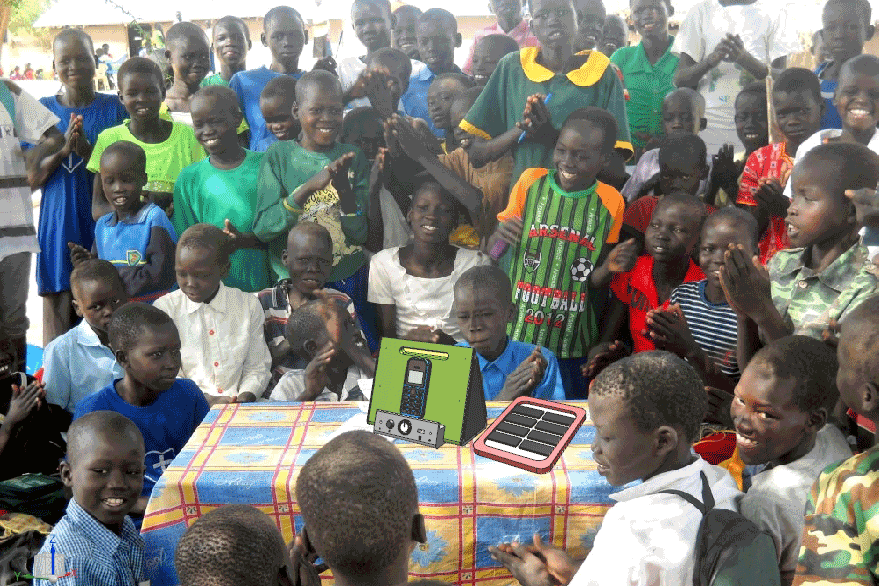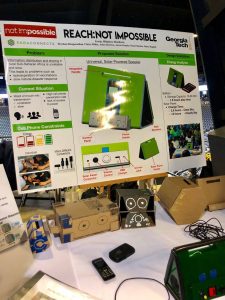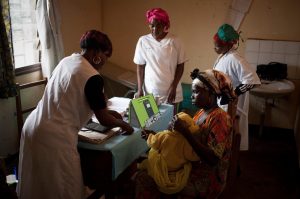
In some developing regions of the world even telephones are rare, and radios non-existent. It is surprisingly not uncommon for a single village leader or benefactor to possess the one handset, serving as conduit for any community information and sharing the device among fellow villagers as needed. Affordability, limited literacy, and poor infrastructure all contributing factors. In some truly remote regions only a single, more expensive satellite phone might service an entire tribe. The challenge taken on by six Georgia Tech mechanical engineering students was to create a simple-to-use device that would receive telephone audio and amplify it so larger audiences can listen together communally. The objective: save hundreds of thousands of children each year by bringing people to vaccines through the delivery of interactive education, alerts and information to remote populations.
The Last Mile Vaccine Crisis – a conundrum where 1.5 million die each year from easily preventable diseases – is a failure of logistics and mass communications to the most vulnerable. For their senior capstone design projects two student teams at Georgia Tech took the gauntlet tossed by Not Impossible Labs and SaraConnects: they devoted the past three months to address and solve these failings with technology. To bring vaccines to people, one team designed an autonomous refrigerated drone-watercraft that pilots itself. I was fortunate to mentor the second team which focused on bringing people to vaccines: delivering education and information to remote populations using common telephones that everybody is familiar with. Their project theme, Reach: Not Impossible.
The premise seems simple; SaraConnects will be deployed into an at risk country as an interactive radio infotainment service to educate, inform and entertain on a grand scale while learning from listeners’ behaviors and interactions. The task of the Reach: Not Impossible team was to invent a solution that leaves nobody without a phone behind and enables larger groups to listen together to the one communal receiving device to share in the listening and learning experience. In reality this is quite complex based upon the environmental conditions we defined for the amplifier: a reliable power source cannot be guaranteed for the telephone, let alone the loudspeaker; nor can Bluetooth be relied upon for connecting – many feature phones still in-use do not have the feature. Thousands of different handsets styles circulating worldwide offer myriad of dissimilar wired connectors with no common standard design among them, making universal compatibility tough. To effectively bring people to vaccines and deliver communal education and information to all, the team found a method to wirelessly receive any phone’s audio directly from its speakers so that a physical audio connection was not necessary and any handset could be amplified.
 On April 24th the Vaccine Not Impossible Consortium of Pfizer, SaraConnects and Not Impossible convened in Atlanta to attend as Georgia Tech hosted its Spring Capstone Expo where nearly two hundred student teams unveiled their inventions to the public. The brilliantly simple Reach: Not Impossible solution advanced to address education and bring people to vaccines features a ruggedized dual loudspeaker upon which any handset could be placed, producing volumes in excess of 90 dB while allowing access to and use of the telephone keypad and microphone for interactivity with programs. The amplifier runs on a rechargeable battery that can simultaneously charge the phone that is providing audio to it. Power can come from any external source including an optional solar panel that can snap into the housing or be used to power other devices when the amplifier is not charging.
On April 24th the Vaccine Not Impossible Consortium of Pfizer, SaraConnects and Not Impossible convened in Atlanta to attend as Georgia Tech hosted its Spring Capstone Expo where nearly two hundred student teams unveiled their inventions to the public. The brilliantly simple Reach: Not Impossible solution advanced to address education and bring people to vaccines features a ruggedized dual loudspeaker upon which any handset could be placed, producing volumes in excess of 90 dB while allowing access to and use of the telephone keypad and microphone for interactivity with programs. The amplifier runs on a rechargeable battery that can simultaneously charge the phone that is providing audio to it. Power can come from any external source including an optional solar panel that can snap into the housing or be used to power other devices when the amplifier is not charging.
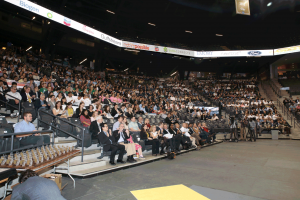
Crowds attending the Georgia Tech Capstone Design Expo at the McCamish Pavilion
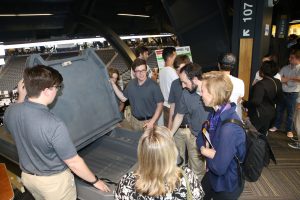
Vaccine Not Impossible Sponsors get introduced to the Lifeboat Autonomous Drone
As this article goes to post a third SaraConnects capstone design project continues underway over the summer, destined for a reveal this fall. I’m mentoring six Georgia Tech electrical engineering seniors who are exploring methods to extend the range of conventional cellular telecommunications towers to reach farther into remote regions. Coupled with the Reach: Not Impossible amplifier at the receiving end, these solutions will ensure our services can reach even the most remote and at-risk populations, bringing people to vaccines through improved awareness and access to information and alerts.
I’m proud of the relationship we are developing with Georgia Tech to harness technology to solve real world problems; their faculty and facilities are world class and the solutions being designed by the exceptional student engineers we’ve mentored are all being considered for field deployment when the Vaccine: Not Impossible initiative moves towards a contemplated comprehensive nationwide pilot of SARA somewhere in sub-Saharan Africa. Each year thousands of children needlessly die due to lack of immunization against preventable diseases. SARA Interactive Radio will connect and educate the disconnected to help ameliorate the last mile vaccine crisis impact and bring people to vaccines they require while authorities collect valuable data that can be used to better anticipate demand and logistics.
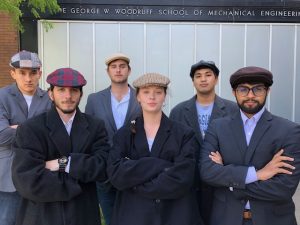
Inventors of the Universal Amplifier: Aaron Orquia, Omar Raslan, Matthew Derrico, Claire Miller, Omar Ragheb, Devshan Renganathan
SARA is a smart cloud – the wireless web in the form of a radically new user browser native to the phone, delivering advanced smartphone functionality to the most basic devices with a friendly interface that is universal, uniform and immediately familiar – like radio, but interactive. SARA permits rapid deployment of services compatible with devices pervasive to all populations, offering radio quality interactive audio via conventional telephony. Her learning, location awareness, blockchain data warehousing and data mining systems facilitate complete control and personalization for each caller regardless their status, and logs each unique individual’s lifetime of interactions with the service. SARA learns about individual listeners, like minded listeners, communities and populations. SARA can become a person’s personal health ID device protected by cloud-based blockchain ledger technology, and can open the portal to a new consumer economy for billions who are unbanked and not online but can connect using their telephone. If you’d like to help get SARA developed and deployed to bring people to vaccines and save lives sooner, we’d love to hear from you.


